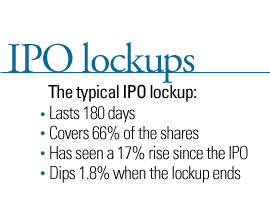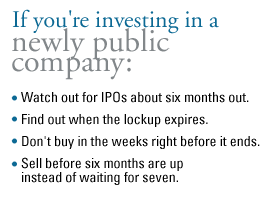|
Be wary of IPO lockup end
|
 |
January 31, 2000: 8:41 a.m. ET
IPOs often take a hit about six months out when insiders are free to sell shares
By Staff Writer Alex Frew McMillan
|
NEW YORK (CNNfn) - Investors love initial public offerings. But if you are lucky enough to land one, tread carefully with a company that has been public for half a year.
If you don't flip an IPO, the typical IPO lockup agreement expires six months out. Lockup agreements prevent insiders from selling stock for a set period, normally 180 days, or six months, after the IPO.
To see what happens when lockup agreements expire, two Penn State University finance professors, Laura Field and Gordon Hanka, looked into 3,217 IPOs with lockups over a 10-year span.
The results, which came out in January, give pause to investors in recently public companies. Field and Hanka found the end of a lockup is a tricky time for both investors who hold the stock and would-be buyers.
Don't let the lockup let you down
Most IPOs have lockups. The typical agreement covers two-thirds of the outstanding shares, according to the Penn State professors.
There are a few reasons why companies and the underwriters that take them public like lockups. Forcing insiders to hold the shares makes sure executives and backers take the company's interests to heart. It reassures new investors that insiders are not out for a quick buck, or an instant one anyway.

But those effects are short-lived. More importantly, lockups help the underwriters generate steady trading for the stock out of the gate. The lack of supply should stop an IPO from collapsing right after the offering.
Watch out at the end of a lockup. The period when the agreement unlocks is not good for investors. There is a "clear decline" in a company's stock price, according to the professors. On average, the stock drops 1.8 percent the week the lockup ends. The dip does not correct itself -- meaning the stock has to wait for other good news to rebound.
Watch out when a company is venture-backed
The price drop has actually been even worse recently, averaging 2.5 percent between 1994 and 1996, Hanka explained. The dip is more dramatic with high-tech and venture-capital backed companies, and there has been a spate of them going public the past few years.
The lockup also causes an immediate increase in trading volume, because there are more shares on the market. There is a sudden flurry of trading right when the lockup ends. Again, that is most noticeable with venture-backed companies, which see their average daily volume rise almost two and a half times at the end of the lockup.
For all companies, trading volume increases 75 percent the day after the unlock day. And the volume increase is permanent, too, though not at the levels at the time the lockup ends. Long term, volume rises 40 percent after the agreement ends.
The price dip and the increased trading are all the more noticeable with venture-backed companies because venture funds sell more aggressively than other IPO shareholders, the professors found. Presumably the VCs want to lock in quick, sure profits.
In fact, taking a company public is often the "exit strategy" or endgame for venture capitalists, who have taken the early risks and see the majority of their investments fail before they make it as far as an IPO.
And what's in it for me?
What should investors make of the end of a lockup agreement? Investors are consistently surprised by it when it comes, even though the date the lockup ends is set at the IPO, so they should be able to anticipate it. The professors cannot figure out why anyone would want to buy a stock the week before its lockup ends. But people still do.
Bearing in mind that a typical lockup lasts 180 days, anyone who is considering buying a stock around six months after an IPO would probably be better off waiting until the lockup ends. Anyone who has IPO shares who does not plan on holding long term should likely sell before the lockup ends.
"If you're going to sell in seven months, you'd probably want to sell in six," Hanka said.

"Our main practical implication is you probably don't want to buy shares in the week or two before the lockup expires," Field added.
It is tempting to consider shorting stocks at the end of a lockup. The professors found that is not normally profitable. The spread you would pay selling at the bid price before the lockup ends and then buying back at the ask price would be greater than the dip in price caused by the end of the lockup. And there would be commissions on top of that. Perhaps a smart investor could short certain kinds of companies, Hanka said, "but shorting these stocks is not something you should do indiscriminately."
Investors keep getting caught out
For some reason, investors have not grasped those effects. There is no dip in the trading volume of IPOs around the expiration of lockups, which shows that some people are still buying in ahead of a sure dip.
"It is surprising to us because it shouldn't be there at all," Field said. Investors who are being scientifically "rational" would find out if the lockup is about to end. And it is easy to find out when a lockup ends. The IPO prospectus or "red herring" will have a section called something like "Shares eligible for future sale." Also, Web sites such as FreeEdgar, on its IPO Express pages, and IPOLockup.com post information on when lockups end.
You will have to track it yourself -- companies hardly ever make any noise about the fact that their lockup period is about to end though, and news stories touting that a lockup is about to end are few and far between. In fact, the professors say it is likely some companies, well aware their lockup is about to end, manufacture news or corporate events like deals or mergers around that time, to mask the effect.
Some lockups let out early
A lockup also is not ironclad, contrary to what many investors may hope and expect. There is always a bit of boilerplate language in the prospectus to the effect that the lockup is at the discretion of the underwriters. The professors found that in six percent of the lockups they looked at, the underwriters allowed substantial insider selling before the lockup was supposed to end.
That typically happens when the stock has risen rapidly. On the one hand, the venture capitalists and executives may step up their pressure to be able to sell at such high prices. On the other hand, the lockup is not necessary from the underwriter's point of view because the stock seems to have the support it needs anyway.
If the breach of a lockup involves mass selling by executives, it is almost always announced publicly, the professors say. Sometimes the announcement comes after the fact, meaning they are practically useless to investors. But breaches of lockups are almost never announced to investors when they involve venture capitalists.
"You can't always know if you're about to get hit," Hanka said. But find out what the terms of the lockup are, and you can take steps to avoid an unpleasant mistake." 
|
|
|
|
|
 |

|

